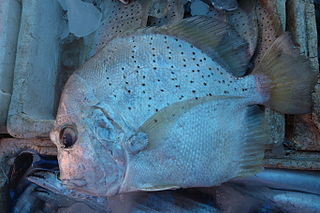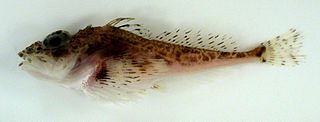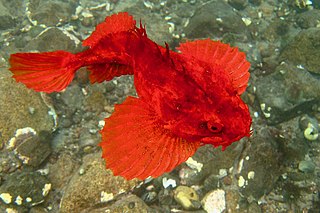
Drepane is a genus of marine and brackish water ray-finned fishes, known commonly as the sicklefishes. It is the only genus in the monotypic percomorph family Drepaneidae. These fish occur in the Indian and western Pacific Oceans, and in the eastern Atlantic near Africa.

Stichaeidae, the pricklebacks or shannies, are a family of marine ray-finned fishes in the suborder Zoarcoidei of the order Scorpaeniformes. Most species are found in the North Pacific Ocean with a few in the North Atlantic Ocean.

The scaled sculpins, Icelus, are a genus of marine ray-finned fishes belonging to the family Cottidae, the typical sculpins. Most of the fishes in this genus are found in the northern Pacific Ocean but they also occur in the North Atlantic Ocean.

Scombrops boops is a species of marine ray-finned fish, a gnomefish from the family Scombropidae in the suborder Percoidei. This species is the most widespread of the Scombropidae, which consists of only four extant species globally. Most of the information about the Scombropidae family is unknown, as they are rarely researched.
Scombrops gilberti is a species of marine ray-finned fish, a gnomefish from the family Scombropidae. It is found in the Western Pacific Ocean where it has been recorded off Hokkaido South to Suruga Bay. It grows To a maximum total length of 120 centimetres (47 in). this species was first formally described as Telescopias gilberti in 1901 by the American ichthyologists David Starr Jordan (1851–1931) and John Otterbein Snyder (1867–1943) with the type locality given as the sea between Misaki, Chiba and Oshima Island in Japan. The specific name honours the American ichthyologist Charles Henry Gilbert (1859–1928).
Scombrops oculatus, the Atlantic scombrops, is a species of marine ray-finned fish, a gnomefish from the family Scombropidae. It is found in the Western Atlantic Ocean.

Mycteroperca is a genus of marine ray-finned fish, groupers from the subfamily Epinephelinae, part of the family Serranidae, which also includes the anthias and sea basses. They are predatory fish, largely associated with reefs and are found in tropical and subtropical seas in the Atlantic Ocean and the eastern Pacific Ocean. They are important target species for fisheries.

Myoxocephalus is a genus of marine ray-finned fishes belonging to the family Cottidae, the typical sculpins. They are found in the northern Pacific, Arctic and Atlantic Oceans, with a few species in lakes.

Zaniolepis, the combfishes, is a genus of marine ray-finned fish, it is one of two genera in the family Zaniolepididae. These fishes are native to the eastern Pacific Ocean. Z. frenata that was a source of food to the Native American inhabitants of San Nicolas Island off the coast of southern California, United States during the Middle Holocene.

The jack-knifefish is a species of marine ray-finned fish belonging to the family Sciaenidae, the drums and croakers. It is native to the western Atlantic Ocean, where its distribution extends along the eastern coasts of the Americas from the Carolinas in the United States to Brazil, including the Caribbean. Other common names include donkey fish and lance-shaped ribbonfish.

Cryptacanthodes is a genus of marine ray-finned fishes belonging to the monogeneric family Cryptacanthodidae, commonly referred to as wrymouths. Three of the four species are found in the Pacific Ocean with one species native to the western Atlantic Ocean where they are benthic fishes, tunneling through soft substrates. It is currently the only known genus in its family.

Easchmeyer nexus is a species of marine ray-finned fish; it is the only species in the monotypic genus Eschmeyer and monogeneric family Eschmeyeridae. This fish is only known from the Pacific Ocean, near Fiji.

Hoplichthys, the ghost flatheads, is a genus of marine ray-finned fishes native to the Indian and Pacific Oceans. This genus is the only member of the family Hoplichthyidae.

Scalicus is a genus of marine ray-finned fish belonging to the family Peristediidae, the armoured gurnards or armored searobins. These fishes are found in the Indo-Pacific region.

Sebastiscus is a genus of marine ray-finned fish belonging to the subfamily Sebastinae part of the family Scorpaenidae. These fishes are native to the western Pacific Ocean. They are collectively called sea ruffes and resemble the rockfishes in the genus Sebastes, but are usually smaller and have a different pattern.

Hemitripterus americanus, the sea raven, is a species of marine ray-finned fish belonging to the subfamily Hemitripterinae of the family Agonidae. The sea raven is found along the Atlantic coast of North America.

Chaetodipterus is a genus of marine ray-finned fishes belonging to the family Ephippidae, the spadefishes. These fishes are found in the Atlantic and eastern Pacific Oceans.

Etelis is a genus of marine ray-finned fish belonging to the family Lutjanidae, the snappers. They are mostly native to the Indian and Pacific oceans with one species (E. oculatus) native to the western Atlantic Ocean.
Scalicus gilberti is a species of marine ray-finned fish belonging to the family Peristediidae, the armoured gurnards or armored sea robins. This species is found in western central Pacific Ocean in Hawaii. Some authorities regard this taxon as a junior synonym of S. engyceros.

Stichaeus is a genus of marine ray-finned fishes belonging to the family Stichaeidae, the pricklebacks or shannies. These fishes are mainly found in the North Pacific Ocean with one species in the Arctic and western North Atlantic Oceans.
















